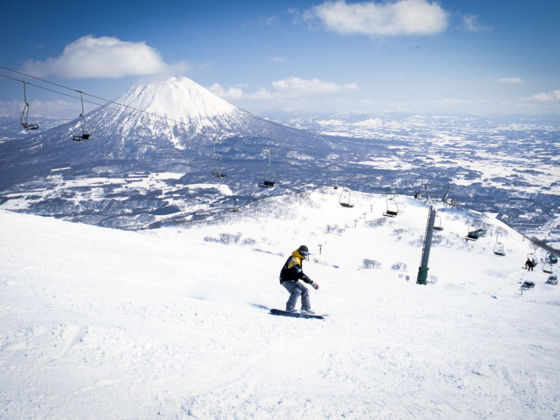Winter in Japan: 2 perfect trips
Japan is marked by a series of handsome mountain chains — you can thank the country’s position on the edge of several colliding tectonic plates for that. And on many of these mountains, winter brings some of the finest powder in the world. So fine, in fact, that powderhounds from across the globe make the trek to ski and snowboard here. Among the many options, two destinations stand out: the northern island of Hokkaido, and the mainland’s prefecture of Nagano.
But it’s not just the snow that gives these places their legendary winter status. You’ll also find natural geothermal springs, fresh local cuisine, and bucolic nature to keep you busy on and off the slopes. Both Hokkaido and Nagano offer so many choices when it comes to wintry playgrounds, it might be hard to choose one over the other. Our advice: choose both.

Down on the main island of Honshu, Nagano is a landlocked prefecture with a spine of 9,000-foot mountains, including the Northern, Central, and Southern Japanese Alps. It’s sometimes called the “Roof of Japan,” with nine of the 12 highest mountains in the country found here — and with that, snow and alpine air are in abundance.
Hokkaido
When you’re looking for consistent deep, dry powder, Niseko is always a safe bet. Located 55 miles southwest of Sapporo in a quasi-national park, the resort zone is centered around Mt. Niseko Annupuri, standing 4,292 feet tall. With a season that runs from late November through April, the Niseko area gets upwards of 50 feet of snowfall per year, fed by coastal moisture and very cold temperatures.
Four resorts work together under the name Niseko United to create interconnected runs over some 2,200 skiable acres, and there are plenty of easily accessible side and backcountry runs for those who want first tracks. Be sure to choose a reputable guide company with avalanche certification; snowmobiling, CAT skiing, and snowshoe tours are just a few of the other off-piste options.
Nagano
With 30+ feet of snow every year, both Nozawa Onsen in northern Nagano and Hakuba Valley in northwestern Nagano are reliable destinations for snow fans looking for some downhill action just a hop and a skip from the metropolis. The area is known for fine weather, so skiers and boarders can enjoy bluebird alpine views before plunging into the powder.
Hakuba Valley, site of the 1998 Winter Olympics, has a variety of terrain that makes it suitable for families and thrill-seekers alike. Ten resorts participate in a common ticket, making it easy to jump from one area to another. Nozawa Onsen combines the ambiance of a traditional hot spring town with excellent runs and over 3,200 feet of vertical. Get off the groomed trails with a backcountry operator, or even try heli-skiing for some truly fresh tracks.
Hokkaido
Onsen are usually connected to lodgings, especially ryokan (Japanese-style inns). Public baths are also available, including some mixed-gender baths where swimsuits are allowed, for those too shy to go nude in traditional onsen. Rotenburo, or open-air baths, let you be at one with nature under the stars, the cold snap of the air neutralized by the mineral steam. All of these and more can be found in Hokkaido.
In Niseko, the public Makkari Onsen has tremendous mountain views. Further afield, the hot spring town of Noboribetsu, on the coast south of Sapporo, is perhaps Hokkaido’s most famous onsen location, set within Shikotsu-Toya National Park. It’s a worthy day trip, with active volcanoes and caldera lakes to explore before sinking into the springs.
Nagano
Ample hot springs in both Nozawa Onsen and Hakuba offer end-of-day rewards for aching muscles. Whether it’s in a refined hotel in Hakuba or the free public hot springs of Nozawa town, there’s a nearby pool to ward off the chill.
Nozawa Onsen has around 30 hot springs, including 13 public baths called soto yu. The adventurous can clop along the streets in wooden clogs, wrapped in yukata (thin kimonos), visiting each in turn. There’s no charge, but honor boxes posted at each bath are there for a few coins’ donation. Meanwhile, at the Hakuba Highland Hotel’s Tenjin no Yu, even non-guests can pay a few hundred yen to access the million-dollar sweeping views of the Northern Alps from the open-air springs.
Hokkaido
Hokkaido is well-known in Japan and beyond for its superlative seafood, caught in the deep, cold oceans fed by the plankton-rich Oyashio Current bordering the island. Crab varieties like snow and king are a specialty (Niseko’s Crab Dining Kanon features three types), as are scallops, fat salmon, and octopus. Try them all together in a kaisen don, or rice bowl, topped with a variety of seafood.
Sea urchin should only ever be eaten fresh, and in Hokkaido, urchin is buttery and sweet, often served as sashimi. Seafood enthusiasts can make a trip to Hakodate’s famous morning market, where 250 vendors hawk freshly caught mackerel, squid, salmon roe, and much more; pull up a plastic chair and get a super-fresh version of the seafood rice bowl here. Heartier regional fare includes salmon hotpot, stewed with vegetables and tofu, and “Genghis Khan” barbecue, featuring grilled mutton and mixed vegetables.
Nagano
All that exertion at elevation works up an appetite. You may think you’ve tried soba (buckwheat) noodles and wasabi back home, but chances are they tasted nothing like they do in Nagano, where soba is grown locally and freshly made noodles are cut daily. And while most tube wasabi is blended with horseradish and food coloring, you’ll get the real thing here, ground moments before eating from the wasabi rhizome — sweet and delicately spicy.
Nagano is also known for wild mountain vegetables and apples, and the cold mountain air and sweet clear water provide the perfect conditions for the dozens of sake breweries around the prefecture that churn out fine local nihonshu (sake) to accompany the fresh mountain fare. Some are even open to tours, though advance booking may be required.
Hokkaido
Wash it all down with one of Hokkaido’s native tipples, such as Sapporo beer, Nikka whisky, or sake from one of the island’s many breweries. Niseko has plenty of wine bars and izakaya (Japanese dining bars), especially in the Hirafu area. Try Toshiro’s Bar for a huge selection of whisky, including many hard-to-find Japanese varieties, or Tamashii for a more classic izakaya experience.
For a big-city buzz, head to Sapporo’s entertainment district, Susukino, which teems with pubs, karaoke bars, and clubs. Check out Bar Yamazaki, a low-key, old-fashioned joint where the bartenders have been plying their trade for half a century, or Bar Orb, a small, friendly LGBT bar with beer, cocktails, and a few snacks.
Nagano
Hakuba’s nightlife runs more sophisticated and international, while in Nozawa, local charm and cultural offerings rule. Tracks Bar in Hakuba Goryu has live music and DJs, while Mocking Bird serves up beer and curry in a rustic, hippie setting.
In Nozawa Onsen, Himatsuri Restaurant and Bar in Ryokan Jonnobi is a sleek, elegant dining-and-drinking experience with refined cuisine like sashimi and tempura served with locally made sake. Beer lovers can head to The Craft Room for craft brews and nibbles.
Hokkaido
To take a break from snow play, head to the east coast of Hokkaido to Kushiro Shitsugen National Park, 100+ square miles of wetlands teeming with wildlife.
The red-crowned crane, or tanchozuru in Japanese, is an important symbol of the country, so much so that it was printed on the old 1,000 yen note. Representing luck and longevity, these usually migratory birds live year-round in the marshes of Kushiro Shitsugen. Winter is their mating season, and their graceful mating dance, red-headed and long-legged, is a sight to behold.
Nagano
Just like humans, the Japanese macaques of Jigokudani (literally “Hell Valley,” named for its sulfurous steam amid steep, craggy cliffs) in northern Nagano love to warm up by taking a soothing soak in the natural hot springs of the so-called Snow Monkey Park.
These wild snow monkeys don’t seem to mind the tourists that come to watch whole families bathing together in the chilly highlands — just don’t try to get in with them. The macaques’ distinctive red, human-like faces peeking out of tan fur only seem to get redder when they’re immersed in the hot water.


